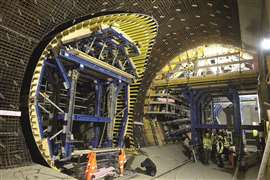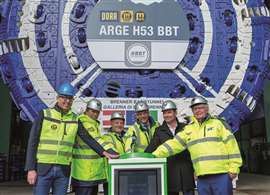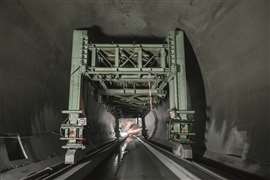Cross-border connectivity: What’s the latest in tunnelling projects across Europe?
12 August 2024
Tunnels connect and expand our methods of travel across the continent. Here Catrin Jones looks at the latest activity at some of Europe’s most complex tunnelling projects.
 By 2028, the new U2 underground line will connect to the main suburban train line at Matzleinsdorfer Platz (Photo: Doka)
By 2028, the new U2 underground line will connect to the main suburban train line at Matzleinsdorfer Platz (Photo: Doka)
Europe is home to some of the most ambitious tunnel engineering feats. The continent is slowly breaking down the barriers to cross-country travel, with seemingly no challenge too great. At the same time, mobility across Europe is becoming easier with the development of new metros and enhanced roadways.
One of the most impressive tunnelling endeavours is the Brenner Base Tunnel (BBT), set to become the world’s longest underground rail link upon completion. Spanning 64 kilometres, this tunnel will connect Innsbruck, Austria, with Fortezza, Italy, significantly reducing travel times, as well as increasing the capacity of freight movement through the Alps.
The BBT is said to be a cornerstone of the Trans-European Transport Network (TEN-T), which aims to enhance cross-border connectivity and boost economic integration within the EU.
Herrenknecht, a Germany-based company that manufactures tunnel boring machines (TBMs), handed over its seventh machine to the project in March 2024.
The new Herrenknecht double shield TBM for the Brenner Base Tunnel has a diameter of 10.37m, a length of around 183m and weighs in at a total of around 2,700 tons.
The transport of the first parts of the machine from the Herrenknecht plant in Schwanau to Austria is expected to start at the end of March. The machine will then be reassembled in the tunnel’s specially designed assembly cavern. The start of the tunnelling is scheduled for autumn 2024.
The eighth, identical double shield TBM for the tunnelling of the second tunnel tube in the H53 Pfons-Brenner construction lot is currently also being built at the Herrenknecht plant in Schwanau and will be delivered in the spring of 2025.
Similarly, the Grand Paris Express, an extensive metro expansion project, is revolutionising public transportation in the French capital. Comprising four new lines and the extension of two existing ones, this project will add 200km of new tracks, linking the city’s suburbs and key business districts. This ambitious undertaking is expected to alleviate traffic congestion, reduce pollution, and provide a seamless travel experience for millions of commuters.
 Herrenknecht supplied a new TBM for the Brenner Base Tunnel project (Photo: Herrenknecht)
Herrenknecht supplied a new TBM for the Brenner Base Tunnel project (Photo: Herrenknecht)
Recently, several new contracts have been awarded, including one to a group led by French contractor Bouygues to build Line 15 East, connecting Bobigny and Saint-Ouen, and another to a joint venture between Italian contractor Webuild and French engineering company NGE, on the western section of Line 15, which involves designing and building four underground stations and 7km of tunnels using TBMs.
Falsework and formwork in tunnelling
Also working on a complex and innovative tunnelling project is falsework and formwork specialist Doka.
The Austrian capital, Vienna, is undergoing a major improvement in public transport, with the extension of the U2 line connecting the city centre and the construction of a new, fully automated line (U5) by 2028.
Doka is playing a key role in this project with its customised formwork solutions, especially at Matzleinsdorfer Platz, where a number of complex tunnel and station structures are being built.
By 2028, the new U2 underground line will connect to the main suburban train line at Matzleinsdorfer Platz, benefiting around 50,000 people in the catchment area. Before this can happen, a total of 1,400m of tunnel needs to be completed around the station.
Given that the Matzleinsdorfer Platz suburban train station will be located directly above the new underground station, the tunnels and formwork face specific challenges. For example, the ground can only be excavated very carefully, requiring special measures.
These include the use of a support disc spring or a “support ring” that is pre-cast in the station tubes – all of which have to be considered in advance in the formwork design by Doka’s engineering team.
Doka provided most of the formwork solutions for the station, including the forming wagon for the two station tunnels, the guiding carriages for the station and line tunnels, and the formwork for an escalator shaft. All the crossings were designed in 3D.
 Construction lot Tulfes-Pfons on the Brenner Base Tunnel (Photo: Brenner Base Tunnel)
Construction lot Tulfes-Pfons on the Brenner Base Tunnel (Photo: Brenner Base Tunnel)
Thomas Staffenberger, director of S&I Unit Eng formwork and infrastructure at Doka, says that the 3D visualisation gives the opportunity to review the solution in its entirety, taking into account all details and nuances.
“Especially with variable geometries,” says Staffenberger. “The entire formwork planning becomes much more efficient and secure, as potential collisions and problems can be avoided in advance.
“Our clients are also pleased to see the complete picture in detail, allowing them to consider all the features in advance and prepare the construction site.”
Safety first
As tunnelling projects are becoming increasingly complex, so they can be more hazardous, leading companies to turn to technology for protecting workers in risky on-site situations.
A group of mechanical and civil engineering, as well as robotic automation industry leaders, which includes Tunnel Engineering Services (UK) (TES), i3D robotics (i3D), the Manufacturing Technology Centre (MTC), Costain, and VVB Engineering, has created the first robotic and AI solution for the installation of mechanical and civil services in tunnels.
Traditionally, installing these services in tunnels is hazardous, labour intensive and time consuming. The prototype Automated Tunnel Robotic Installation System (ATRIS) is said to be able to autonomously select brackets, locate where they need to be mounted along a tunnel wall, and install them.
Once fully developed, the group says that the final system can be deployed in tunnel construction for various sectors, including transport, water, and energy. The machine is predicted to increase productivity by 40% by enabling faster installation, reduce installation costs for new mechanical and electrical (M&E) systems by 30%, and decrease construction plant movements by 40%, thereby reducing embodied carbon.
Steve Nesbitt, chief technologist for the built environment at MTC, says, “Like many sectors, construction has faced labour challenges over the past few years which has driven greater interest in using robots, beyond manufacturing and logistics, to address these issues.
“By contributing our expertise to this project, we are paving the way for construction companies to adopt technology for greater control and structuring of on-site works, making infrastructure delivery safer, more productive, and more sustainable.”
Lee Bateson, mechanical and engineering manager and robotics lead at Costain, adds, “Teaching the robots to learn seemingly simple tasks – such as how to avoid cross-threading the screws that go into the sockets – has been hugely fulfilling, thanks to the consortium’s collaborative spirit.
“Whether it is carbon reduction, increasing productivity or improving workforce health and safety, this is a transformative technology that will have enormous benefits for the customers that we build tunnels for.”
Simplifying challenges
 Automated Tunnel Robotic Installation System (ATRIS) (Photo: Andrei Zota/ Costain)
Automated Tunnel Robotic Installation System (ATRIS) (Photo: Andrei Zota/ Costain)
Amberg Technologies is also addressing modern tunnelling challenges with a mission to simplify tunnel surveying.
The Switzerland-based company’s system of solutions under the umbrella name of Amberg Tunnel combine precise measuring instruments with task-specific software. Significant improvements in efficiency are realised, especially in tunnel navigation, tunnel profile measurements, tunnel scanning, geotechnical analysis and as-built tunnel analysis.
The company were recently involved in a large-scale tunnel project in Sweden. The Stockholm bypass – Förbifart Stockholm – is a new route for the European highway (E4) past the Swedish capital. The infrastructure project, once completed, will feature one of the world’s longest motorway tunnels.
Designed within a Building Information Modelling (BIM) environment, the tunnel complex includes main passages, crosscuts, ventilation shafts, and access tunnels. The “FSE305 Bergtunnlar Lovö” section, noted for its intricate geometry, presented significant surveying challenges. The main hurdle, says Amberg Technologies, has been processing the extensive data collected and delivering timely reports.
The Swedish tunnel surveyor on the project is said to have juggled multiple local software platforms, leading to significant inefficiencies. Amberg Tunnelscan was employed to streamline the process by focusing on tunnel-specific challenges.
The company says the software supports direct data import from scanners and provides tools for georeferencing and data cleaning. In addition to this, the software organises scans systematically so that users can generate tailored analysis and reports directly from the platform.
These are just a few examples of how ambitious tunnel projects across Europe can be. With modern technology and streamlined ways of working, these projects can redefine transportation and bring other benefits to thousands of people each day. We have never been more connected than we are now, and projects are set to become even larger as we continue to build extensive tunnels across the continent with the help of advanced tech and enhanced safety systems.



